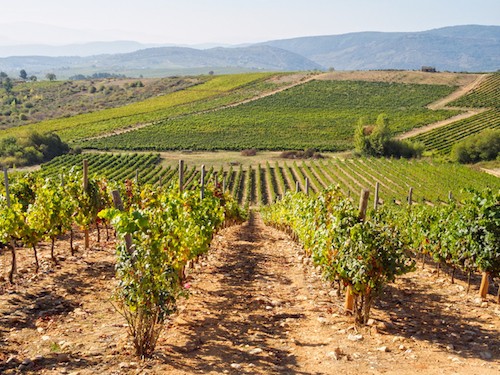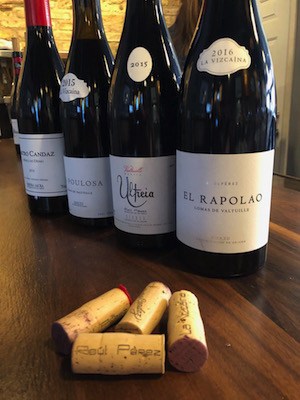I have had the good fortune to travel through Spain numerous times and it continues to call me back. From Madrid and Sevilla, to Cordoba, Arcos, Jerez, Granada, Segovia, Rioja and the coasts, it spun its magical web, cradling me in its passion, warmth, joy, mysticism and bewitching contradictions. It has left an indelible impression deep within my soul and it always has a way of presenting exactly what I need, at the very time I need it.
RELATED: Learn About Sherry Wines and Jerez Spain
Perhaps this feeling, or connection, is why for years I have been drawn to the Camino de Santiago, a 500-mile journey from Saint Jean Pied de Port in France to Santiago de Compostela, in the Galicia region of Spain that has been continually traversed since 812 A.D. It’s a trek I know I need to make and there is indeed something drawing me to this path.

So, when I recently attended a Master Class in Chicago on the wines of Bierzo and the Mencía, you can imagine my excitement when on the label of these wines was the word, “Ultreia.” Ultreia is an ancient word used on the Camino by fellow travelers as a phrase of encouragement, meaning “Let’s go further,” or “keep going beyond.” And when I met our teacher, the renowned winemaker, Raúl Pérez, I knew I needed to go beyond.
Who is Raúl Pérez?

Raúl is a presence. He doesn’t quite reach my height, his long, curly dark hair is tied back and his salt and pepper colored beard is one of which many hipsters would be envious. He is soft spoken and only speaks in Spanish to his translator. But while he’s a man of few words, the words he shares are laced with his passion, experience and soul. This is what captured my attention most during the class at which he spoke. While I learned a great deal about the climate, soils and grapes of Bierzo, the real value was an understanding of Raúl’s intense drive, masterful expertise and how each wine is representative of far more than the land.
Wine on the Camino de Santiago
Raúl’s family winery, Castro Ventosa, is located in Valtuille de Abajo in the Bierzo region of northwest Spain. The winery and winemaking of his family date back to 1752; however, the vineyards of the region have a much longer history. The vines are believed to have been brought by the Phoenicians after which they were truly cultivated for wine by the Romans. Then during the 9th century, the monks of the Catholic church began producing wines in the region along the Camino de Santiago. In fact, the Camino runs directly through the vineyards and towns from which both the Castro Ventosa and Raúl Pérez wines are produced. As the church lost power throughout the 1800s the land was divided among noble families within the region where it was continually fragmented with each generation. Today the 5,000 hectares of vineyards are divided into approximately 7,000 plots owned by an astonishing 5,000 land owners.
In the early years of Castro Ventosa, the grapes were grown and wines produced for commercial purposes and sold to other labels. In the 1980s, the family began to bottle wines under their own name, and in the 1990s, Raúl trained formally before beginning his real education as a winemaker in 1996. The vineyards of Bierzo are like a jigsaw puzzle with various plots and owners mixed together. Today, Raúl operates his own winery, Raúl Pérez Bodegas y Viñedos where the wines change depending on the nature and creativity of Raúl. However, there are two philosophies to which he is committed: 1) to exert the minimum influence on the grape and 2) to create styles that inspire and excite him. And much like those walking the Camino, he goes beyond – often well beyond.
A Winemaker’s Signature
Raúl’s methods include observing every type of soil, studying each plot’s individual micro-climate and obsessively watching the ripening times of every grape variety. In doing so, he’s able to get the best expression of his grapes without any additives necessary to transform it into his unique style of wines. In the cellar, he takes the lead from his fermentation vessels, of which he uses several types and all of which are meant to have as little influence on the wine as possible. The result is Raúl’s unmistakable signature on his wines.

As an example, let’s look briefly at a few of Raúl’s wines, starting with the Sketch. The Albariño grapes for the Sketch are sourced from the Rías Baixas where westward-facing vineyards have a constant wind from the sea. These grapes are not harvested when most Albariño is typically picked. Instead, Raúl waits until the last possible moment, as late in harvest as possible. He then presses the grapes, decants into two 700-litre French barrels, which for this last harvest were on their 14th use, and where spontaneous fermentation takes place. There is no malolactic fermentation owing to the grapes’ natural loss of acid with the late harvest. He does not touch the wine until bottling the next year. The result is an incredibly unique Albariño that although having less acidity than most of this variety, still presents with high acidity on the palate.
Another of the wines Raúl produces unlike any other in the world, is the Bierzo Tinto, Ultreia De Valtuille. This wine is a blend featuring the Mencía, Trousseau, Alicante Bouschet, Godello and Doña Blanca; however, the Mencía is the most prominent. The Mencía grape is grown throughout Bierzo and is known for presenting heady aromas, spice, minerality and both savory and gamey notes. It has a wild quality to it, which somehow seems fitting for this winemaker who not coincidentally aims to raise the profile of this particular variety. The grapes for this blend are selected from a single vineyard, 850 metres above sea-level in Raúl’s hometown of Valtuille de Abajo. The grapes are whole-cluster fermented with native yeasts in a large, open-top chestnut vat for a 60 to 90-day maceration. This is then followed by one-year of aging in neutral barrels under flor, which allows for oxygenation without oxidation, before being bottled without fining or filtration. (And yes, flor, or a layer of wild yeasts, to form a cap over the wine, the same thing used to make Spanish Sherry.) The result? An incredibly structured wine with a savory start and a long, fruit-driven finish.

Although Raúl has numerous wines and labels, the last one I will mention here for its signature uniqueness is the Tierra De Leon Blanco [Albarin], Bodegas Y Vinedos Raul Perez. The grapes for this wine are sourced about 100 kilometers southeast of Bierza in the village of Villamañan from about 950-metres above sea-level where they receive little rain. The days are warm and nights cool and it’s here where Raúl grows his Albarin grapes. The Albarin is not native to the region, nor is it related to Albariño, but these vines have been here since 1970. An early ripening and aromatic grape, Raúl handles them in his own signature way – very minimally. The grapes are harvested and fermented in two very old 500-litre barrels in a subterranean cave where they age under flor for at least four or five years with no additives and no intervention. For me the nose of this wine was incredibly intense and reminiscent of a Fino with its almond and green apple characteristics; however, the palate was altogether unique and unlike any wine I have previously experienced. It was incredibly dry with a lush viscosity and notes of salinity, almond, lemon and apricot. A truly unique wine.
Raúl pushes the limits. He is an innovator and someone that bucks at convention. He lets the land, climate, grapes and process speak and he is astoundingly successful at it because he listens. Like the roads throughout Spain, life is a series of roundabouts. Sometimes you go back, sometimes you go the wrong-way, and many times you move forward taking with you all that came before. And like the Camino de Santiago, it is a journey and an exploration. Raúl’s wines move me in much the same way – backwards, forwards and taking me on an exploration of all that came before. I do plan to someday walk the Camino, and when I do, you can bet I’ll be stopping in Bierzo as part of that journey.
